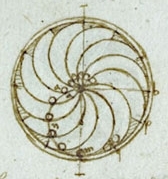A puzzle from Leonardo's notebooks.
 |
| Leonardo's drawing. |
|---|
This drawing was found on a page of Leonardo da Vinci's notebooks. The page contained similar devices thought to be, at the time, perpetual motion wheels. Leonardo knew they couldn't turn continually by themselves, but was apparently fascinated with them for a while, and analyzed them to see why they don't work. His sketches show he was doing torque analysis.
This wheel was not original with Leonardo. It was an idea that may go back to the 4th century CE.
Even without the text, this picture is remarkable. Leo effectively uses a theorem of geometry, showing that the balls on the left will follow a semi-circular path of the same radius as the curved semi-circular sectors they roll on. That much is correct.
There are clearly more balls to the left of the axle, a minor point. But the puzzing thing about this figure is that the gravitational torques on the balls (with the center of torques at the axle) do not add to zero. This net torque is counter-clockwise. So, the naive student wonders, why doesn't the wheel rotate counter-clockwise continually?
Do not be distracted by the "extra" ball in the shaded area just to the right of the vertical axis at the bottom of the wheel. Either it is a mistake, not fully erased, or Leo was using it to make some point. It does not compromise this puzzle.
I'd like think Leo was making a joke here. But perhaps he didn't see the error in the drawing.
Answer:
The picture shows the wheel supposedly at rest, or a "snapshot" of it in slow motion.If it is at rest, the net gravitational torque on the balls about the axle is nonzero and from this starting position the wheel would turn counterclockwise.
The cluster of five balls just above the axle have near-zero net gravitational torque. The ball at the very bottom (labeled m) has zero torque. The remaining balls clearly have net counter-clockwise torque.Could this picture be a snapshot of the wheel rotating counterclockwise?
Leo's drawing is deceptive. If the wheel is slowly rotated once around, the balls would not be in the positions shown. A ball rising on the right will not move away from the rim toward the center until it has risen to near the top. The picture shows three balls near the axle, prematurely. These three should still be near the wheel's rim. If drawn correctly, with those balls at the rim, the sum of torques on the balls is zero. Leo's little joke? Or was he deceived by other drawings he'd seen of this wheel? In either case, this demolishes the claim that the balls are "overbalanced".
Additional unnecessary observations.
Suppose there are N balls in N chambers. If we assembled the balls one at a time, putting a brake on the wheel to prevent its rotation, we could place the balls in the position shown. When the brake is released, the wheel would rotate counter-clockwise and settle to one of N equilibrium positions, due to frictional energy loss. In this position the net torque on the balls will be zero.Could Leo's picture be a snapshot of a wheel rotating slowly clockwise? No, in any of N positions the wheel has the same configuration of balls, and those positions all have net counter-clockwise torque, opposing clockwise motion.
A minor detail. The shadded areas near the rim seem to serve the function of preventing balls from being lodged in the narrow ends of their chambers. But if so, what prevents the balls just above the axle from being lodged there?
Leo provides, on all such drawings, a vertical line with hash marks to indicate a vertical line, which is good because these figures are oriented various ways on the manuscript pages. So, what position of this figure would put the wheel in equilibrium. Make a copy of this on paper and rotate it until the gravitational torques on the balls are balanced. It would require rotation of approximately 30° counter-clocwise.
Return to Physics puzzles.
Return to The Museum of Unworkable Devices.
Return to the Donald Simanek's home page.